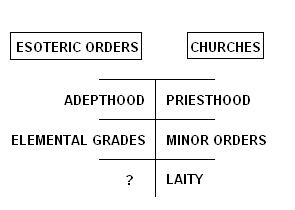[A Note: While we are traditionally familiar with the idea of a Priest being male, in Gnostic tradition there have always been women in the Priesthood and Episcopacy (Bishop-hood), and, as far as I’m concerned, always will be. Thus, the terms “Priest” and “Priesthood” used below are used in a very generic sense.]
One of the most common criticisms of the “priestly caste” is that such people act as intermediaries, as an elect or elite, and take away from that personal communion with God. It is a valid criticism, of course, and one of the main reasons why people have flocked to alternative paths that allow you to “be your own priest”.
One thing I have to ask, however, is why can’t you be your own priest in a mainstream tradition? I mean, surely the option of becoming a priest is open to people (women can become priests in certain traditions, such as Gnosticism, for example)? Of course, I understand that the phrase “be your own priest” is usually used as not referring to a vocation in the Priesthood, but to the general idea of personal communion with the Divine, which many, often rightly, feel is withheld from them in organisations like the Church.
Now, what has this got to do with the notion of the Priesthood? Well, firstly, those who undertake the work of an esoteric order must go through a series of grades before Adepthood. This is exactly the same in an ecclesiastical structure (which is, let’s face it, just another structure for working with the Divine, but one that is often a lot more open than esoteric orders). Instead of the Elemental Grades, there are Minor Orders, and these can be attributed to the Sephiroth (which you can see more clearly in Fr. Jordan+’s post here). The priest goes through these “grades” just as the initiate of an esoteric school does, and when they arrive at the necessary stage, they enter Adepthood – or Priesthood. I covered some more links between the Priest, the Adept, and Tiphareth in my previous post on the Eucharist, which you can find here.
Now, if we look at it, there is less difference between the idea of an ecclesiastical body and an esoteric order than we might have at first assumed. The same, or, at least, very similar, structures are in place, with similar goals, and a very similar hierarchical make-up. For initiates in these orders, they look to the Adept as a teacher, as one who has gone through the system and can help them do the same. Likewise with the Priesthood. Perhaps the only difference, which is a major one, is that an esoteric order is, by its very nature, a closed group. It is not for the many, just as the Priesthood is not for the many. When you join an esoteric order, you are, effectively, already engaged in the Formation to Priesthood, which is merely termed Adept in that system. In an ecclesiastical structure, there is a new element – the laity. Instead of closed group-ritual, such as that in an esoteric order, which is only open to those who are Adepts (Priests) or those in the Elemental Grades (Minor Orders, in Formation for the Priesthood [Adept]), there is a new group of people, the general congregation, who can participate freely in the rites held, without being obligated to undergo the same Formation that is present in the quest for priesthood or Adepthood in their respective bodies.
So, to those who are indeed members of an esoteric order and criticize the notion of the Priesthood, I would ask that they look at the same (or, at least, very similar) process they are undergoing, and realise that the divide is where we make it, or where we perpetuate it. For those undergoing the various initiations in an esoteric order and who proclaim that they are their own priest, I would again ask that they look at those who are undergoing the same (or, at least, very similar) process in an ecclesiastical body, who are indeed their own priest.
Now to one of the last elements that needs addressing. You do not need to be a Priest, an Adept, or one undergoing Formation or Initiation in either a church or esoteric order to seek, find, and experience communion with the Divine. Yes, when you are participating in a group ritual such as that of the Eucharist, of course there is a certain structure that must be followed, with certain Officers fulfilling essentially symbolic (and alchemically potent) roles that you may not be sufficiently trained to undertake. This is the same as that of an Initiation Ceremony in an esoteric order (albeit, with the new, more open, element of the laity). But, outside of group ritual, you are indeed “your own priest”, if you consider a Priest to be merely an intermediary with the Divine. You are your Higher Self. That is your intermediary. Everyone has one, and everyone needs to commune with and assimilate this essentially “Divine Self” into their life to effectively attain, amplify, and share their own gnosis. You can pray, perform ritual, and meditate – you do not need to go to a priest to experience the Divine in your life, remember that. The purpose of group ceremonies is similar to that of initiations – they’re supposed to help plant seeds in you, seeds that you water, seeds that you shine your own divine light upon, and seeds that you ultimately nurture until they grow and bear fruit, a process which happens outside of Church or
Thursday, September 28, 2006
On The Priesthood
Subscribe to:
Post Comments (Atom)








No comments:
Post a Comment